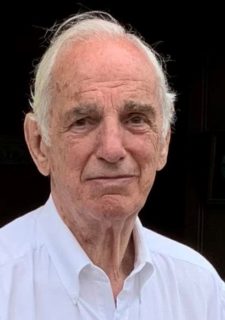Article begins

Image description: A man with white hair wears a white collared shirt in front of a black background.
Caption: Neville Dyson-Hudson
1929–2021
Neville Dyson-Hudson died on January 23, 2021, at his home in Ithaca, New York. He was born on October 25, 1929, in Manchester, England, and spent a part of his youth in a foster home. He rose to the rank of second lieutenant in the British Army (1948-1950) before attending Cambridge University, receiving the BA/MA in 1953. It was at Cambridge where he first met Rada Demerec (1930–2016), an American completing her DPhil at Oxford University in Drosophila genetics and systematics. They married in 1953 at Oxford, where Dyson-Hudson had joined Rada, and the two began a lifelong research collaboration on studies of East African pastoralists. Neville completed the DPhil at Oxford in 1960 in social anthropology with E. E. Evans-Pritchard as his mentor.
Between 1955 and 1958, the couple conducted field research in northeast Uganda among the pastoral Karimojong. Dyson-Hudson collected ethnographic and ecological data for his dissertation while Rada began her transition from Drosophila geneticist to anthropologist. Dyson-Hudson’s fieldwork was reported in the monograph Karimojong Politics (1966) and in papers on “the Karimojong age system” in Ethnology (1963) and “Factors inhibiting change in an African society” in Transactions of the New York Academy of Sciences (1962). Following his Karimojong research, Dyson-Hudson took a position at the University of Khartoum, where he did research with the Eastern Sudanese Beja people. He then moved to the Johns Hopkins Department of Social Relations where he remained for a decade before taking a position at Binghamton University, SUNY in 1973. During the period before arriving at Binghamton, Dyson-Hudson and Rada had already established international reputations as experts on African pastoral peoples and rangelands societies.
In the mid-1970s, Dyson-Hudson, with colleagues in anthropology at Binghamton University and rangelands scientists from Colorado State University, began planning a multidisciplinary project to study the ecology of nomadic Turkana pastoralists, a population closely related to the Karimojong in language and culture, in northwest Kenya. The project was conceptualized by Dyson-Hudson’s vision of integrated science involving long-range studies based on the adaptation of pastoral nomadism to the dry savanna of East Africa. Funding for this project began with the National Science Foundation (NSF) Anthropology Program, while later funding was granted by the Biological Division of the NSF. The South Turkana Ecosystem Project continued from 1980 for nearly two decades and culminated in more than 200 publications in anthropology, rangelands science, ecology, and biomedicine. A book, Turkana Herders of the Dry Savanna (1999), synthesized much of the anthropological work. The success of this project remains a tribute to Dyson-Hudson’s vision.
Dyson-Hudson was a talented intellect and voracious reader who had many interests inside and outside of anthropology. On his classical and humanistic side, he loved music, especially opera, and literature: his favorites were Mozart and Shakespeare. On his less classical side, he also loved Monty Python. Many years ago when death was distant, Dyson-Hudson and I discussed our choices of music to be played at our funerals. Despite his love of Mozart, he chose the second movement of Brahms’s German Requiem (“Behold All Flesh Is as the Grass”) and Strauss’s Vier Letzte Lieder #3 (“When Falling Asleep”). He is survived by one daughter, Amanda, two sons, Nigel and Trevor, and a grandson, Terence Dyson-Curran.
(Michael A. Little)
Cite as: Little, Michael A. 2021. “Neville Dyson-Hudson.” Anthropology News website, March 19, 2021. DOI: 10.14506/AN.1601

